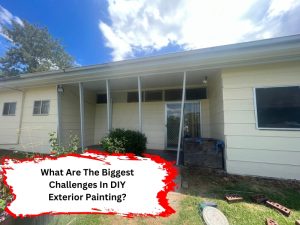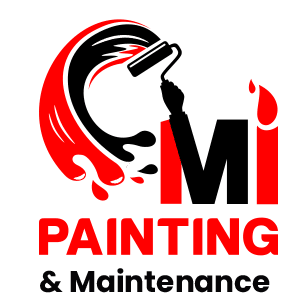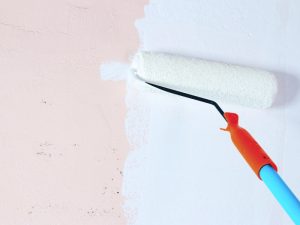What Are The Biggest Challenges In DIY Exterior Painting?

Taking on a DIY exterior painting project may seem like an exciting way to refresh your property. However, it comes with many challenges that can impact the final result. Each step requires careful planning, from unpredictable weather to surface preparation and choosing the right paint. If mistakes are made, they can lead to peeling, uneven coverage, or premature fading. So, before grabbing a brush, it’s essential to understand the potential obstacles and how to overcome them.
What are common mistakes in DIY exterior painting?
Even with the best intentions, many DIY painters make errors that compromise the quality and durability of their work.
Common DIY Exterior Painting Mistakes
- Skipping surface preparation – Dirt, mildew, or old paint residue can prevent new paint from adhering correctly.
- Painting in poor weather conditions – High humidity, intense sunlight, or windy conditions can cause drying issues.
- Using low-quality paints and tools – Cheap paint fades quickly, while inferior brushes and rollers leave streaks.
- Not applying primer when needed – Bare wood or previously unpainted surfaces require priming for better adhesion.
- Applying paint too thick or too thin – Thick layers can crack, while thin layers won’t provide adequate coverage.
- Ignoring safety precautions – Working at heights without proper gear can lead to accidents.
Avoiding these mistakes ensures a smoother, longer-lasting finish. Proper preparation, choosing quality materials, and adhering to best practices make all the difference.
Why is surface preparation crucial before exterior painting?
A poorly prepped surface leads to peeling and premature wear. Proper preparation ensures that the paint sticks well and lasts longer.
Essential steps for surface preparation
- Cleaning the surface: Use a pressure washer or a scrub brush with detergent to remove dirt, mould, and grease.
- Sanding and scraping – Smooth rough areas and remove loose paint to prevent uneven patches.
- Repairing damaged areas – Fill cracks and holes with exterior-grade filler.
- Priming bare surfaces – Apply a primer to unpainted surfaces or areas with exposed wood.
- Taping and covering non-painted areas – Protect windows, doors, and landscaping.
Proper surface preparation results in a professional-looking, durable paint job. Skipping these steps can lead to peeling and uneven finishes.
When is the best time to paint the exterior of your home?
Choosing the right season for DIY exterior painting is crucial for optimal results. Australia’s changing weather and climate significantly impact paint application and drying times.
Best painting seasons in Sydney
Season | Ideal for Exterior Painting? | Notes |
Spring (Sep-Nov) | Yes | Mild temperatures and lower rainfall make it ideal. |
Summer (Dec-Feb) | No | High heat can cause paint to dry too fast, leading to cracks. |
Autumn (Mar-May) | Yes | Cool and stable weather allows proper drying. |
Winter (Jun-Aug) | No | Cold and damp conditions slow drying and affect adhesion. |
Choosing the right season ensures a flawless finish. Spring and autumn offer the best conditions for exterior painting in Sydney.
Can you paint over old exterior paint?
While painting over existing paint is possible, it requires careful preparation to ensure a smooth finish.
Steps for painting over old exterior paint
- Assess the Condition – If the existing paint is peeling, bubbling, or cracking, it must be removed first.
- Clean the Surface – Wash away dirt, mildew, and chalky residue before painting.
- Lightly Sand Glossy Paint – This helps the new paint bond better.
- Use Primer If Necessary – If the old paint is significantly different in colour or shows signs of deterioration, apply a primer.
- Choose Compatible Paint – Ensure the new paint type (oil-based or water-based) matches or is suitable for the existing layer.
Painting over old paint can save time, but only if done correctly. Proper surface cleaning and preparation prevent peeling and uneven coverage.
How do you avoid common DIY exterior painting mistakes?
Even if you’re a beginner, there are ways to ensure your DIY exterior painting project turns out as planned.
- Plan ahead: Take the time to plan your project, including colour selection and tools needed.
- Choose quality materials: Invest in quality paint and tools for the best results.
- Properly prepare the surface: Cleaning, sanding, and priming are essential steps that shouldn’t be overlooked.
- Work in the right conditions: Paint during dry weather with mild temperatures to ensure optimal drying and curing conditions.
- Don’t rush: Allow adequate drying time between coats, and always use a primer.
- Follow proper techniques: Learn the right techniques for applying paint to avoid streaks or uneven coverage.
Following these steps can avoid common mistakes and achieve a professional-looking finish.
What are the safety risks in DIY exterior painting?
While DIY exterior painting can be rewarding, there are safety risks that you should be aware of. Take these precautions to stay safe during your project:
- Ladder safety: Ensure your ladder is stable and flat to avoid falls.
- Ventilation: If using strong-smelling paints, ensure proper ventilation to avoid inhaling fumes.
- Lead paint: Older homes may have lead-based paint requiring special handling and safety measures.
- Protective gear: Wear protective clothing, gloves, goggles, and a mask to protect yourself from paint splatters and fumes.
- Sun exposure: Painting outside can expose you to direct sunlight for long periods. Wear sunscreen and stay hydrated.
Taking safety seriously reduces the risk of injury. Proper gear and precautions ensure a smooth painting experience.
How do you maintain a long-lasting finish on exterior paint?
After investing time and effort into your DIY exterior painting project, you’ll want to maintain the finish for years. Follow these tips for long-lasting results:
- Clean regularly: Dirt and debris can build up over time. Clean the exterior with a gentle pressure wash or by wiping down surfaces.
- Touch up as needed: Inspect your paint job regularly and touch up areas that may be peeling or fading.
- Apply a protective coating: Consider using a clear protective topcoat to shield the paint from the elements.
- Keep trees trimmed: Overhanging branches can scratch or damage painted surfaces.
Keeping your home’s exterior well-maintained will allow you to enjoy a fresh, vibrant look for longer.
When should you consider hiring a professional for exterior painting?
While DIY exterior painting can be a great way to save money, there are certain situations where hiring a professional is the best choice. Consider the following:
Aspect | DIY Exterior Painting | Professional Exterior Painting |
Cost | Lower initial cost | Higher cost due to expertise |
Time | Takes longer | Faster completion |
Quality | Dependent on skill level | High-quality, consistent results |
Equipment | Basic tools | Advanced equipment and materials |
Risk | Possible mistakes, safety concerns | Minimal risk, expert handling |
If you struggle with the scale or complexity of your project, hiring professional exterior painting services ensures a high-quality finish with fewer headaches.
To DIY or not to DIY?
DIY exterior painting can be rewarding but also challenging. Many factors influence the outcome, from weather conditions to safety risks and surface preparation. While small projects may be manageable, larger jobs often require professional expertise for a flawless, long-lasting finish.
Looking to enhance your property’s curb appeal? Mi Painting & Maintenance offers professional exterior painting services throughout Sydney. Our skilled team provides high-quality workmanship, ensuring a flawless finish with durable results that withstand the harsh climate. From meticulous surface preparation to expert application, we guarantee your home or business will shine. Contact Mi Painting & Maintenance today for a free quote, and let us bring your vision to life.


